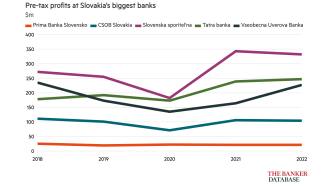The Yugoslav banking market was considered to be the most progressive and liberal of its kind as early as the 1960s, a reputation it retained until the late 1980s. Ten years of military conflict, geopolitical disputes, and political and economic isolation resulted in the loss of this pioneering role, and in the emergence of various monetary, banking, regulatory and supervisory regimes in the State Union of Serbia and Montenegro.
It is in this new context that the pioneers of the past and the stragglers of the present are trying to catch up with their counterparts in central and eastern Europe.
Reform begins
In 2000, a turnaround in political thinking in the form of a new government and the related easing in the country’s economic isolation heralded the beginning of banking reform. The revitalisation of the banking sector commenced with the ratification of two new laws: “the law governing the relations between the Federal Republic of Yugoslavia and banks within the territory of the Federal Republic of Yugoslavia, being the original debtors or guarantors toward the Paris Club and London Club creditors” and the “law on the settlement of the public debt of the Federal Republic of Yugoslavia arising from the citizens’ foreign exchange savings”.
An extensive screening of the banking sector began in the context of the new legal framework. It included the classification of the commercial banks into four groups, according to liquidity and solvency, and prompted the Bank Rehabilitation Agency to close 19 smaller insolvent banks in 2001. This accounted for about 10% of the sector’s total assets.
At the beginning of 2002 this was followed by the closure of the four largest Serbian banks (Jugobanka, Beobanka, Beogradska Banka, Investbanka) on account of fiscal restrictions. Based on the sector’s total assets, these banks had a market share of 57% and a recapitalisation requirement of an estimated €4bn.
As in other transition countries in central and south-east Europe, the opening of the market for private banks, lax licensing regulations and low capital requirements led to a sharp rise in the number of banks in Serbia at the beginning of the 1990s, peaking at 112 in 1995. Almost 10 years and the first round of banking reform later, the number has dropped by two-thirds, but at 43, at the end of 2004, it remained high. The fact that about half these banks have a market share of less than 1% illustrates the need for further consolidation.
The privatisation process is, however, making only slow progress. The state has privatised only one bank since the beginning of banking sector reforms. But more is happening besides the privatisation of state-owned banks. Foreign banks seem to prefer to strengthen their market positions via mergers with and acquisitions of other private, foreign participants, without waiting for bank restructuring to be completed.
At 38.4%, the market share of foreign-owned banks – although for the first time higher than that of the state in terms of 2003 total assets – was still fairly low compared with other transition countries and reflects the moderate progress in bank privatisation. Measured in terms of capital, the market share of foreign-owned banks was much lower at 26.3%.
Serbia’s banking sector is still in its infancy. The extent to which the banking market is underdeveloped is apparent both in absolute and relative terms. At the end of 2004, the sector’s total assets amounted to a mere €6.5bn. At 38.8%, the level of financial intermediation (the banking sector’s aggregated total assets as a percentage of GDP) was consequently a little over one-third of GDP. In comparison, in Austria the figure was 270% of GDP, and the EU-15’s average was about 200%.
The level of financial intermediation declined sharply mainly as a result of restructuring measures (closure of insolvent banks) in 2001 and 2002, even if this indicator with respect to the past does not paint a true picture in light of the high inflation and exchange rate volatility that has characterised previous years.
Savings habit
The growing presence of foreign-owned banks on the Serbian market has also increased the population’s saving propensity. Last year, for example, saw the third consecutive sharp rise in savings both in absolute terms and in relation to GDP. Despite these initial successes, there is an enormous amount of work to be done to regain depositors’ confidence and to facilitate the mobilisation of savings. The bulk of the population still keeps savings under the mattress. But even if these savings find their way to the bank, people prefer to place their money on short-term deposit (95% of private sector deposits). Also, given the origin of funds transferred by guest workers, people like to invest savings in foreign currency (two-thirds of all private sector deposits), primarily in euros, indicating a lack of confidence in Serbia’s national currency, the dinar. Banks hold most of customers’ foreign currency deposits with the National Bank of Serbia for the purpose of ensuring structural liquidity.
Consolidation phases
Despite the numerous achievements, there is much work and catching up to be done in regard to banking reform and improving efficiencies. The banking market is overbanked but under-serviced. The first phase of consolidation (2001-2004) is therefore likely to be followed by two others – one in the form of privatisation in 2005–2010, and the other in the form of mergers and acquisitions (2010-2015). During the consolidation process it is important to optimise not only the quantity but also the quality of banking services, so moving from the mainly basic banking products currently offered, to more sophisticated services.
The major challenge remains public confidence in regard to both the banking system and the national currency.
Measures to strengthen public confidence would help on the one hand to channel the transfers of guest workers living abroad into the monetary system and, on the other hand, the development of a healthier balance-sheet structure (avoidance of currency and maturity mismatch) – with positive external effects for domestic demand and the economy’s development.
The lack of confidence in banks is reflected by the fact that the most important financing methods employed by small and medium-sized enterprises, aside from own funds, is financing by family or transfers by guest workers, with funding by banks coming in third place.
Banking reform must also be accompanied by reform of the enterprise sector, which continues to operate within a framework of soft budget constraints. In this respect, reform measures that create a sound basis for banking operations are inevitable. The lack of collateral and the tedious process of the enforcement of creditors’ rights remain an obstacle to lending (especially in regard to loans to corporates), even if the situation is expected to improve with the introduction of the new and more flexible Insolvency Law, which came into effect on February 1.
Standards framework
Similarly, the creation of a risk-adequate legal framework based on international and European standards must continue to be given top priority. The consistent enforcement of legal standards to reduce the high-risk behaviour of individual banks is equally important.
One of the key challenges regarding the creation of a strong legal framework is the reform of the deposit guarantee scheme, which would facilitate the mobilisation of savings. Further issues that need to be more properly addressed are the wrapping-up of the bad debt problem; completion of the privatisation process; strengthening of corporate governance; and regaining public confidence in the banking sector.
These issues are all the more important as the domestic economy’s current robust condition and bright growth prospects, coupled with the progress made in enterprise restructuring, provide favourable conditions for dynamic banking market growth in the coming years.
This is an excerpt from a longer article by Marianne Kager and Sandor Gardo, economists with Bank Austria Creditanstalt.











